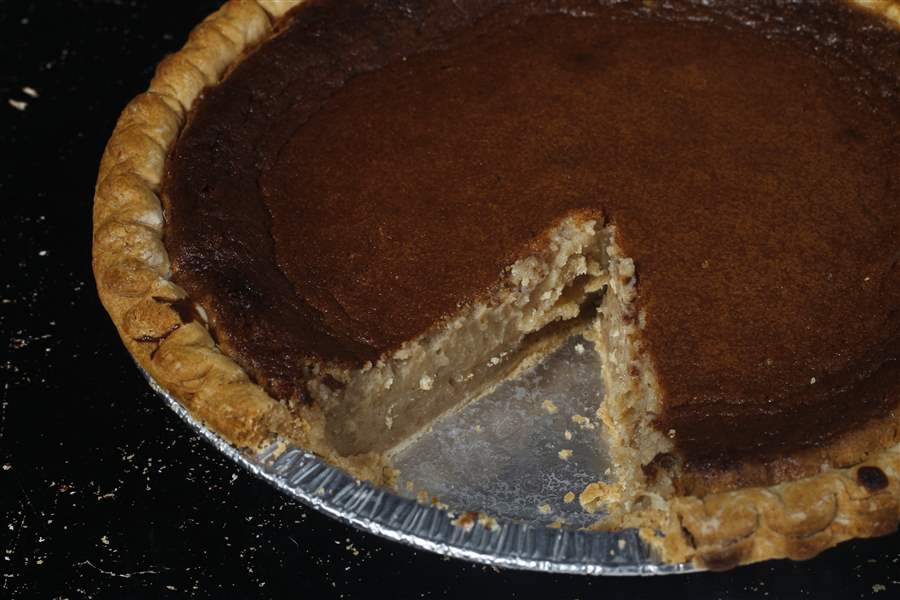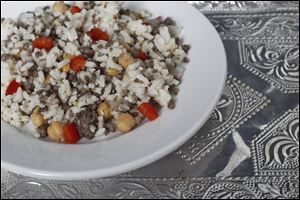
Ramadan: Fasting takes some work, but there are rewards at the end
7/17/2012
Bean Pie is one of the many foods served during Ramadan.
The Blade/Amy E. Voigt
Buy This Image

A rice and beef dish that is one of the many foods served during Ramadan.
It seems like a paradox: a food story about Ramadan.
Ramadan, after all, is a time of fasting, a time for Muslims to forsake food and other pleasures of the flesh in favor of introspection, meditation, and self-discipline. Beginning at sundown Thursday and lasting until Aug. 18, more than 1 billion Muslims around the world will welcome the opportunity to purify their bodies and their minds in an effort to become closer to Allah.
But a person has to eat, even a person seeking holiness. So the tradition is to eat a fairly large meal before dawn, called suhoor, and then another meal after sunset, called iftar.
Ramadan is the ninth month of the Islamic lunar calendar, and it is said to be the month in which the Qu'ran was revealed to Muhammad, according to Kassem Allie, executive administrator for the Islamic Center of America in Dearborn, Mich.
Fasting is a joyful obligation throughout the month -- it is one of the five pillars of the faith -- and everyone is expected to participate except children, anyone whose health might be affected (including pregnant or breast-feeding women), travelers, the mentally ill, and menstruating women, Mr. Allie said.
Adults who miss fasting during Ramadan are expected to make up the days they miss later if they are physically able to do so, he said.
"The fundamental idea is that fasting shouldn't harm you [but] it's not supposed to be easy, it's supposed to be difficult. That's part of the benefit of fasting, is to be able to withstand discomfort," Mr. Allie said.

Bean Pie is one of the many foods served during Ramadan.
Throughout the month, Muslims refrain from eating, drinking, and sexual relations from sunup to sundown. They redouble their efforts to be generous, to be communal with other people, and to give to charity, especially at the end of the month.
After the sun has gone down, it is traditional not to gorge oneself, at least not immediately. The typical snack to break the fast is a glass of water and a few dates, which were favored by Muhammad to end a day's fasting. Almonds, too, are often nibbled once the sky has darkened.
These are often followed by a cup of soup, usually lentil soup, Mr. Allie said, and then a salad such as fettoosh. The rest of the meal is whatever the cooks want to make, often featuring the bold flavors and vibrancy of the many cuisines of the Middle East, the center of Islam.
One example is Rooz Ma Lahem, a dish of rice with meat. Served as either a side dish or a main course, this is a fairly standard mixture of rice and ground meat (usually lamb, though beef and turkey also will work well). Most cultures have a similar dish, but this version stands out because of its blend of uniquely Mediterranean spices including garlic, allspice, and especially cinnamon. If you eat a savory dish with cinnamon, you can bet that it comes from a country near the Mediterranean sea.
Though used sparingly in Rooz Ma Lahem, the cinnamon (and allspice and onions) adds a wallop of flavor that brings out the best in the lamb.
A good bet for the pre-dawn suhoor meal is a Turkish dish called cilbir, which places poached eggs on a bed of garlicky yogurt. Use as much of the pungent garlic as you like, but remember it is raw and therefore quite powerful. The dish is topped with a very simple sauce made of paprika mixed into melted butter.
The paprika is important not only for the wonderful flavor it brings (and it melds surprisingly well with the butter), but also for the shock of color. Without the paprika, the dish would be white poached eggs on white yogurt.
So what's for dessert? How about a sweet associated with some Muslims in America, a bean pie?
Bean pie is one of those dishes you have to convince people to try, but if they have it once they need no more convincing. With its custard base of eggs, egg yolks, and condensed milk, and flavors of cinnamon, nutmeg, and vanilla, its taste is not unlike a pumpkin pie, though with a chewier, denser texture.
The rewards of Ramadan are said to be more heavenly than based on earth. But if you're going to fast all day, you may as well end the fast with something as delicious as a bean pie.
Contact Daniel Neman at dneman@theblade.com or 419-724-6155.
Rooz Ma Lahem (Rice with Meat)
5 cups cooked rice
1/2 pound ground lamb OR beef OR turkey
⅓ cup diced onions
3 garlic cloves, minced
1/2- 3/4 teaspoon allspice
1/4 teaspoon (heaping) cinnamon
1 tablespoon salt, or to taste
1 teaspoon garlic powder
1/2 teaspoon black pepper
1/4 cup diced red pepper, optional, for color
1 (15-ounce) can chickpeas, drained
Set cooked rice aside.
In a large pot over medium-high heat, combine ground meat, onions, garlic, allspice, cinnamon, salt, garlic powder, black pepper, and optional red pepper. Add a little oil if the food starts to stick to the bottom of the pot. Cook, stirring often to break up clumps, until the meat is nearly browned. The meat should be the consistency of taco meat.
Add the drained chickpeas and cook until the meat browns. Drain off excess fat, if any. Add rice and stir until well blended.
Yield: 6 servings
Source: Adapted from food.com
Turkish Poached Eggs (Cilbir)
2 cloves garlic, minced
1 1/2 cups plain yogurt
1 pinch salt
1 quart water
1 tablespoon vinegar
6 eggs
2 tablespoons butter
1 teaspoon paprika
In a small bowl, combine garlic, yogurt, and salt. Mix well.
In a large saucepan or stockpot, combine water and vinegar over medium-high heat. When the water is barely simmering, gently crack in the eggs, spacing them far apart so their yolks do not mingle. Keep the water at a bare simmer while they cook for 3 minutes. Remove with a slotted spoon, quickly dry with paper towels, and place on serving plates.
Melt butter in a small skillet or saucepan. Stir in paprika. Pour yogurt sauce over eggs and top with paprika butter.
Yield: 2-3 servings (6 eggs)
Source: Adapted from allrecipes.com
No Fail Bean Pie
1 deep-dish prepared pie crust
1 (15.5-ounce) can navy beans, rinsed and drained
6 ounces sweetened evaporated milk ( 3/4 cup, half of a 12-ounce can)
1/4 cup butter ( 1/2 stick), melted
1/2 teaspoon cinnamon
1/2 teaspoon nutmeg
1 tablespoon all-purpose flour
1 1/4 cups white sugar (see cook's note)
1 tablespoon vanilla extract
1 egg
1 egg yolk
Cook's note: This makes a fairly sweet pie. Use a little less sugar for a less-sweet pie.
Preheat oven to 450°. Place pie crust into a 9-inch pie dish. This isn't essential, but will make it easier to handle the pie.
In a food processor, place the navy beans, evaporated milk, melted butter, cinnamon, nutmeg, flour, sugar, vanilla extract, egg, and egg yolk. Pulse the mixture a few times until smooth, about 1 minute. Pour the filling into the pie crust.
Bake at 450° for 15 minutes, then reduce the heat to 350° and bake until the filling is set and the crust is golden brown, an additional 35 minutes. Cool before slicing. Eat warm or cold. Refrigerate leftovers.
Yield: 12 servings
Source: allrecipes.com